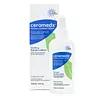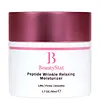What's inside
What's inside
 Key Ingredients
Key Ingredients

 Benefits
Benefits

 Concerns
Concerns

 Ingredients Side-by-side
Ingredients Side-by-side

Water
Skin ConditioningCaprylic/Capric Triglyceride
MaskingGlycerin
HumectantCetearyl Alcohol
EmollientGlyceryl Stearate Se
EmulsifyingCeramide NP
Skin ConditioningLecithin
EmollientAlpha-Glucan Oligosaccharide
CleansingOphiopogon Japonicus Root Extract
Skin ConditioningCoco-Caprylate/Caprate
EmollientButyrospermum Parkii Butter
Skin ConditioningGlyceryl Linoleate
EmollientGlyceryl Linolenate
EmollientDimethicone
EmollientTocopherol
AntioxidantGlyceryl Oleate
EmollientPotassium Cetyl Phosphate
EmulsifyingPanthenol
Skin ConditioningAllantoin
Skin ConditioningAlgae Extract
EmollientAloe Barbadensis Leaf Juice
Skin ConditioningUlva Lactuca Extract
Skin ConditioningYeast Extract
Skin ConditioningAscorbic Acid
AntioxidantHydrolyzed Soy Protein
HumectantRosa Canina Fruit Oil
EmollientXanthan Gum
EmulsifyingMaltodextrin
AbsorbentMethylpropanediol
SolventDidecyldimonium Chloride
EmulsifyingSorbitol
HumectantPolyquaternium-80
CleansingCaprylyl Glycol
EmollientWater, Caprylic/Capric Triglyceride, Glycerin, Cetearyl Alcohol, Glyceryl Stearate Se, Ceramide NP, Lecithin, Alpha-Glucan Oligosaccharide, Ophiopogon Japonicus Root Extract, Coco-Caprylate/Caprate, Butyrospermum Parkii Butter, Glyceryl Linoleate, Glyceryl Linolenate, Dimethicone, Tocopherol, Glyceryl Oleate, Potassium Cetyl Phosphate, Panthenol, Allantoin, Algae Extract, Aloe Barbadensis Leaf Juice, Ulva Lactuca Extract, Yeast Extract, Ascorbic Acid, Hydrolyzed Soy Protein, Rosa Canina Fruit Oil, Xanthan Gum, Maltodextrin, Methylpropanediol, Didecyldimonium Chloride, Sorbitol, Polyquaternium-80, Caprylyl Glycol
Water
Skin ConditioningPentaerythrityl Tetraethylhexanoate
EmollientGlycerin
HumectantDimethicone
EmollientMica
Cosmetic ColorantPolyglyceryl-4 Stearate
EmulsifyingSilica
AbrasiveIsononyl Isononanoate
EmollientMacadamia Ternifolia Seed Oil
EmollientMyristyl Myristate
EmollientAcetyl Glucosamine
Skin ConditioningS-Mu-Conotoxin Cniiic Acetate
Skin ConditioningAcetyl Hexapeptide-8
HumectantAmaranthus Caudatus Seed Oil
EmollientHordeum Vulgare Extract
EmollientTriticum Vulgare Germ Oil
EmollientLeuconostoc/Radish Root Ferment Filtrate
AntimicrobialPolyglutamic Acid
Skin ConditioningBetula Alba Bark Extract
MaskingHydrolyzed Vegetable Protein
Skin ConditioningStearyl Alcohol
EmollientPolysilicone-11
Glycyrrhetinic Acid
Skin ConditioningNiacinamide
SmoothingCaffeine
Skin ConditioningCocos Nucifera Oil
MaskingSodium Hyaluronate
HumectantPunica Granatum Sterols
Skin ConditioningCocos Nucifera Water
MaskingCocos Nucifera Fruit Juice
EmollientSucrose
HumectantLinoleic Acid
CleansingSodium Stearoyl Glutamate
CleansingCetyl Alcohol
EmollientCoconut Alkanes
EmollientPotassium Cetyl Phosphate
EmulsifyingButyrospermum Parkii Butter
Skin ConditioningDicaprylyl Ether
EmollientAcrylates/C10-30 Alkyl Acrylate Crosspolymer
Emulsion StabilisingTromethamine
BufferingSqualane
EmollientPropanediol
SolventSodium Citrate
BufferingSorbic Acid
PreservativeCitric Acid
BufferingCoco-Caprylate/Caprate
EmollientSodium Benzoate
MaskingLecithin
EmollientOrmenis Multicaulis Oil
MaskingSalvia Sclarea Oil
MaskingHydroxyacetophenone
Antioxidant1,2-Hexanediol
Skin ConditioningCaprylyl Glycol
EmollientGlyceryl Caprylate
EmollientTrisodium Ethylenediamine Disuccinate
Glyceryl Undecylenate
EmollientLinalool
PerfumingWater, Pentaerythrityl Tetraethylhexanoate, Glycerin, Dimethicone, Mica, Polyglyceryl-4 Stearate, Silica, Isononyl Isononanoate, Macadamia Ternifolia Seed Oil, Myristyl Myristate, Acetyl Glucosamine, S-Mu-Conotoxin Cniiic Acetate, Acetyl Hexapeptide-8, Amaranthus Caudatus Seed Oil, Hordeum Vulgare Extract, Triticum Vulgare Germ Oil, Leuconostoc/Radish Root Ferment Filtrate, Polyglutamic Acid, Betula Alba Bark Extract, Hydrolyzed Vegetable Protein, Stearyl Alcohol, Polysilicone-11, Glycyrrhetinic Acid, Niacinamide, Caffeine, Cocos Nucifera Oil, Sodium Hyaluronate, Punica Granatum Sterols, Cocos Nucifera Water, Cocos Nucifera Fruit Juice, Sucrose, Linoleic Acid, Sodium Stearoyl Glutamate, Cetyl Alcohol, Coconut Alkanes, Potassium Cetyl Phosphate, Butyrospermum Parkii Butter, Dicaprylyl Ether, Acrylates/C10-30 Alkyl Acrylate Crosspolymer, Tromethamine, Squalane, Propanediol, Sodium Citrate, Sorbic Acid, Citric Acid, Coco-Caprylate/Caprate, Sodium Benzoate, Lecithin, Ormenis Multicaulis Oil, Salvia Sclarea Oil, Hydroxyacetophenone, 1,2-Hexanediol, Caprylyl Glycol, Glyceryl Caprylate, Trisodium Ethylenediamine Disuccinate, Glyceryl Undecylenate, Linalool
 Reviews
Reviews

Ingredients Explained
These ingredients are found in both products.
Ingredients higher up in an ingredient list are typically present in a larger amount.
This ingredient is also known as shea butter. It is an effective skin hydrator and emollient.
Emollients help soothe and soften your skin. It does this by creating a protective film on your skin. This barrier helps trap moisture and keeps your skin hydrated. Emollients may be effective at treating dry or itchy skin.
Shea butter is rich in antioxidants. Antioxidants help fight free-radicals, or molecules that may harm the body. It is also full of fatty acids including stearic acid and linoleic acid. These acids help replenish the skin and keep skin moisturized.
While Shea Butter has an SPF rating of about 3-4, it is not a sunscreen replacement.
Shea butter may not be fungal acne safe. We recommend speaking with a professional if you have any concerns.
Learn more about Butyrospermum Parkii ButterCaprylyl Glycol is a humectant and emollient, meaning it attracts and preserves moisture.
It is a common ingredient in many products, especially those designed to hydrate skin. The primary benefits are retaining moisture, skin softening, and promoting a healthy skin barrier.
Though Caprylyl Glycol is an alcohol derived from fatty acids, it is not the kind that can dry out skin.
This ingredient is also used as a preservative to extend the life of products. It has slight antimicrobial properties.
Learn more about Caprylyl GlycolCoco-Caprylate/Caprate is created from fatty coconut alcohol, caprylic acid, and capric acid.
It is a lightweight emollient. Emollients create a thin barrier on the skin to trap moisture in. This helps keep your skin hydrated and soft.
Once applied, Coco-Caprylate/Caprate is absorbed quickly and leaves a silky feel.
Coco-Caprylate/Caprate may not be fungal acne safe.
Learn more about Coco-Caprylate/CaprateDimethicone is a type of synthetic silicone created from natural materials such as quartz.
What it does:
Dimethicone comes in different viscosities:
Depending on the viscosity, dimethicone has different properties.
Ingredients lists don't always show which type is used, so we recommend reaching out to the brand if you have questions about the viscosity.
This ingredient is unlikely to cause irritation because it does not get absorbed into skin. However, people with silicone allergies should be careful about using this ingredient.
Note: Dimethicone may contribute to pilling. This is because it is not oil or water soluble, so pilling may occur when layered with products. When mixed with heavy oils in a formula, the outcome is also quite greasy.
Learn more about DimethiconeGlycerin is already naturally found in your skin. It helps moisturize and protect your skin.
A study from 2016 found glycerin to be more effective as a humectant than AHAs and hyaluronic acid.
As a humectant, it helps the skin stay hydrated by pulling moisture to your skin. The low molecular weight of glycerin allows it to pull moisture into the deeper layers of your skin.
Hydrated skin improves your skin barrier; Your skin barrier helps protect against irritants and bacteria.
Glycerin has also been found to have antimicrobial and antiviral properties. Due to these properties, glycerin is often used in wound and burn treatments.
In cosmetics, glycerin is usually derived from plants such as soybean or palm. However, it can also be sourced from animals, such as tallow or animal fat.
This ingredient is organic, colorless, odorless, and non-toxic.
Glycerin is the name for this ingredient in American English. British English uses Glycerol/Glycerine.
Learn more about GlycerinLecithin is a term for a group of substances found in the cell membranes of plants, animals, and humans. They are made up of mixture of phospholipids.
This ingredient has emollient and emulsifying properties.
As an emollient, lecithen helps soften the skin and creates a barrier to keep moisture in.
As an emulsifier, it also helps prevent water and oil ingredients from separating. Lecithin can also help ingredients be better absorbed by the skin.
This is because the phospholipids in lecithin produce liposomes. Liposomes help other ingredients get through the skin barrier.
Depending on the source of this ingredient, lecithin may not be fungal acne safe. This is because some sources of lecithin come from soybean oil, which may feed the malassezia yeast that feeds fungal acne.
We recommend reaching out to the brand you are purchasing from to inquire about the source of their lecithin.
Some other names for this ingredient include soy lecithin and deoiled soy lecithin.
Learn more about LecithinPotassium Cetyl Phosphate is the potassium salt of a mixture. This mixture consists of the esters from phosphoricacid and cetyl alcohol.
Potassium Cetyl Phosphate is an emulsifier and cleansing agent. Emulsifiers help stabilize a product. It does this by preventing certain ingredients from separating.
As a cleansing agent, Potassium Cetyl Phosphate helps gather oils, dirts, and pollutants from your skin. This makes it easier to rinse them away with water.
Learn more about Potassium Cetyl PhosphateWater. It's the most common cosmetic ingredient of all. You'll usually see it at the top of ingredient lists, meaning that it makes up the largest part of the product.
So why is it so popular? Water most often acts as a solvent - this means that it helps dissolve other ingredients into the formulation.
You'll also recognize water as that liquid we all need to stay alive. If you see this, drink a glass of water. Stay hydrated!
Learn more about Water